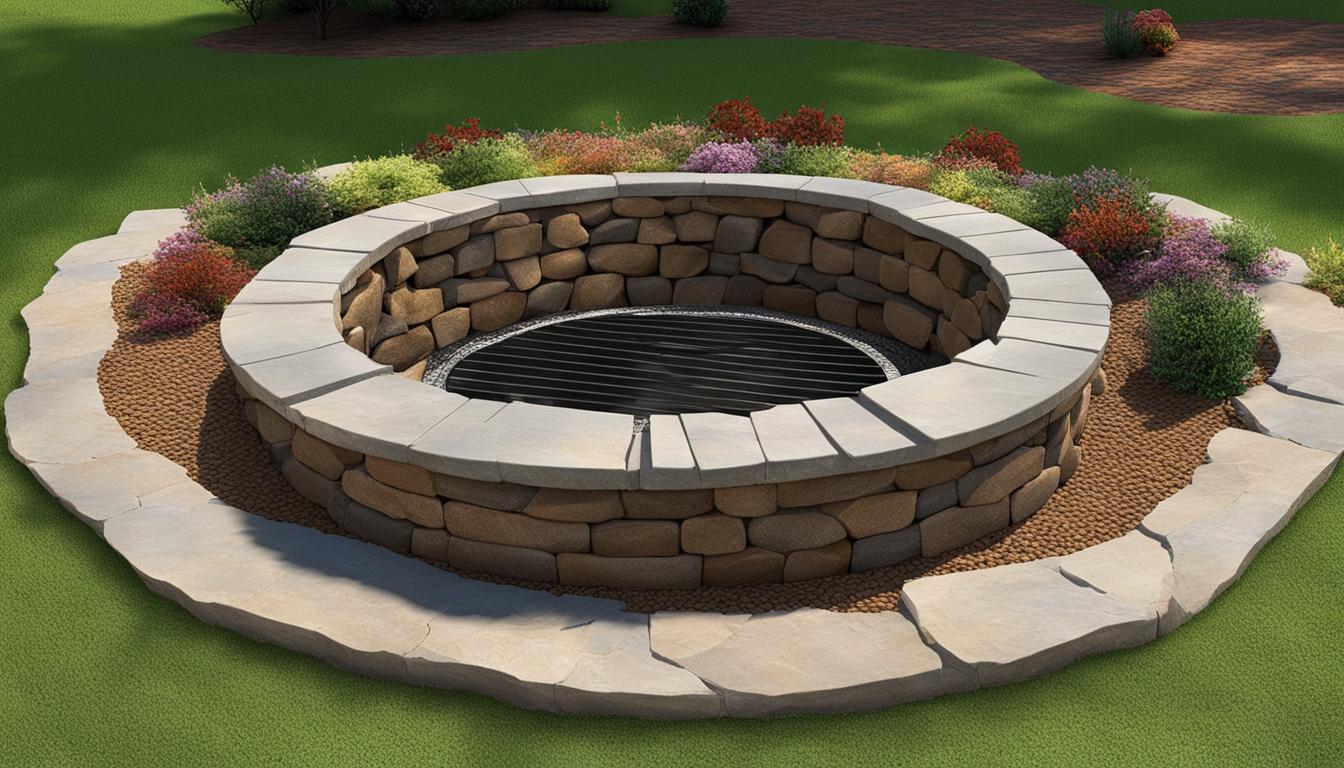Building a smokeless fire pit is a fantastic way to enhance your outdoor space and enjoy a cozy fire without the nuisance of smoke. In this guide, I will provide you with all the information and ideas you need to make your own DIY smokeless fire pit that fits your style and preferences.
Key Takeaways:
- Creating a DIY smokeless fire pit allows you to enjoy a cozy fire without smoke.
- Choosing the right materials such as stainless steel, cast iron, and firebricks is crucial for constructing a smokeless fire pit.
- Consider various designs, like wood-burning fire pits with smoke-reducing features or gas-powered fire pits with smokeless burners.
- Plan ahead and prepare the area before starting the construction process of your smokeless fire pit.
- Building a sturdy and level base is the first step in constructing your smokeless fire pit.
Choosing the Right Materials
When it comes to building a smokeless fire pit, selecting the appropriate materials is crucial for ensuring its functionality and longevity. The right materials should be able to withstand high temperatures and promote efficient airflow, creating a smokeless environment. Here, I will discuss some popular options for smokeless fire pit construction, including stainless steel, cast iron, and firebricks.
Stainless Steel: Stainless steel is a durable and corrosion-resistant material that is commonly used in smokeless fire pit construction. It can withstand high temperatures without warping or deteriorating, making it an ideal choice for long-lasting performance. Additionally, stainless steel promotes efficient airflow, allowing the fire to burn cleanly and reducing the production of smoke.
Cast Iron: Cast iron is another popular material for smokeless fire pits. It has excellent heat retention properties, allowing the fire pit to radiate warmth even after the fire has died down. Cast iron is also known for its durability and ability to withstand extreme temperatures. However, it is important to note that cast iron fire pits may require regular maintenance, such as seasoning and occasional re-painting, to prevent rust and prolong their lifespan.
Firebricks: Firebricks, also known as refractory bricks, are heat-resistant bricks designed specifically for fire pit construction. These bricks are capable of withstanding high temperatures without cracking or breaking. By using firebricks in the construction of your smokeless fire pit, you can ensure optimal heat distribution and efficient airflow, resulting in a more smokeless burn.
Choosing the right materials for your smokeless fire pit is essential for creating a safe, efficient, and smoke-free fire experience. Consider the specific properties of each material and select the one that best suits your needs and preferences.
Designing your Smokeless Fire Pit
When it comes to designing your smokeless fire pit, you have a plethora of options to choose from. The design you select should not only enhance the aesthetic appeal of your outdoor space but also effectively reduce smoke for a more enjoyable experience. Consider the size of your space, your desired aesthetic, and the overall functionality you want to achieve when selecting a design for your smokeless fire pit.
Here are some popular designs to inspire you:
- A wood-burning fire pit with a built-in smoke-reducing feature: This type of fire pit incorporates a unique design element that helps minimize smoke. It may include features like an additional chimney or specialized ventilation system to ensure proper airflow and reduce smoke output.
- A gas-powered fire pit with a smokeless burner: These fire pits use propane or natural gas as fuel, offering a clean and smoke-free fire experience. They often come with smokeless burners that efficiently burn the fuel, minimizing smoke production.
- An elevated fire pit with a unique airflow system: Elevating your fire pit can promote better air circulation and reduce smoke. This design may include features like raised platforms, perforated walls, or additional ventilation channels to enhance the smokeless effect.
Ultimately, the choice of design depends on your personal preferences, the available space, and the desired level of smoke reduction. Make sure to consider the specific features and benefits of each design option before making a final decision.
For an example of a smokeless fire pit design, take a look at the image below:

Planning and Preparing for Construction
Before embarking on the construction process of your smokeless fire pit, it is crucial to have a well-thought-out plan in place. This will ensure that the project goes smoothly and that you have everything you need to create a successful smokeless fire pit.
Here are some steps to follow when planning and preparing for the construction:
- Map out the size and location: Determine the dimensions and placement of your fire pit. Consider factors such as available space, proximity to flammable materials, and the desired focal point of your outdoor area.
- Gather the tools and materials: Make a list of all the tools and materials you will need for the construction. This may include items such as shovels, bricks, gravel, a level, and a masonry saw. Ensure that you have everything on hand before you begin the project.
- Prepare the installation area: Clear the area where the fire pit will be installed. Remove any debris, rocks, or vegetation that may interfere with the construction process. Level the ground to provide a stable base for your fire pit.
- Check local regulations: Before proceeding with the construction, familiarize yourself with any local building codes or regulations regarding fire pit installations. Ensure that your plans comply with these requirements to guarantee safety and avoid potential issues.
By carefully planning and preparing for the construction of your smokeless fire pit, you can ensure a smooth and efficient building process. This will set you up for success in creating a beautiful and functional outdoor feature for your enjoyment.
With a clear plan in place, you’re now ready to move on to the next stage of building your smokeless fire pit. In the next section, we will discuss the important steps involved in constructing the fire pit base.
Building the Fire Pit Base
The first step in constructing your smokeless fire pit is building the base. This is an essential component that provides stability and ensures the longevity of your fire pit. When it comes to choosing the materials for the base, there are several options that you can consider:
Concrete Blocks
Concrete blocks are a popular choice for building the base of a smokeless fire pit. They are durable, affordable, and easy to work with. You can arrange the blocks in a circular or square shape, depending on your desired design, and secure them using construction adhesive or mortar.
Pavers
Pavers are another excellent option for creating a sturdy base. They come in various shapes, sizes, and colors, allowing you to customize the look of your fire pit. Just like concrete blocks, pavers can be arranged in a circular or square pattern and secured together with adhesive or mortar.
Metal Ring
If you prefer a more minimalist and modern look, a metal ring can be used as the base for your smokeless fire pit. Stainless steel or cast iron rings are commonly used for this purpose. They provide a clean and sleek appearance while offering excellent durability. To create the base, simply place the metal ring on a level surface.
No matter which materials you choose, it’s crucial to ensure that the base is leveled and stable. This will prevent any shifting or tilting of the fire pit, ensuring a safe and enjoyable experience for you and your guests.
Now that you have built the base, you can move on to the next step of constructing your smokeless fire pit. In the following section, I will guide you through creating an efficient airflow system, which is essential for smoke reduction and a pleasant fire pit experience.
Creating Airflow System
To achieve a smokeless fire pit, it’s essential to design an efficient airflow system. Proper air circulation allows for the efficient burning of fuel and the escape of smoke. There are several methods you can employ to create an effective airflow system for your smokeless fire pit.
Adding Vents or Channels
One way to improve air circulation is by incorporating vents or channels in the walls of your fire pit. These openings allow fresh air to enter the fire pit, promoting combustion while facilitating the escape of smoke. By strategically placing vents or channels at key locations, you can ensure proper air movement and minimize smoke production.
Incorporating a Secondary Combustion Chamber
An effective technique to reduce smoke in your fire pit is by incorporating a secondary combustion chamber. This chamber can be designed to burn off any remaining smoke or combustible gases that were not fully burned in the initial combustion process. By providing a second opportunity for complete combustion, you can significantly reduce smoke emissions and enjoy a cleaner fire.
Smokeless Burner
Another option is to consider using a smokeless burner in your fire pit. Smokeless burners are specially designed to achieve efficient combustion with minimal smoke production. They utilize innovative technology and features such as air vents, pre-mixed fuel, and controlled airflow to achieve smokeless burning. Smokeless burners are available in various designs and sizes to fit different fire pit configurations and can be a great addition to your smokeless fire pit construction.
By incorporating these airflow systems and technologies into your smokeless fire pit design, you can create a pleasant and enjoyable fire experience without the annoyance of smoke. Ensuring efficient air circulation and complete combustion will result in a smoke-free ambiance for you and your guests to enjoy.
| Benefits of an efficient airflow system in a smokeless fire pit |
|---|
| 1. Reduced smoke emissions |
| 2. Increased combustion efficiency |
| 3. Cleaner and healthier fire experience |
| 4. Elimination of smoke odors |
| 5. Enhanced safety by reducing the risk of unburned gases |
Choosing the Right Fuel
The type of fuel you use in your smokeless fire pit can significantly impact its smokelessness. Opting for the right fuel can help you create a more enjoyable and smoke-free outdoor experience. Here are some options to consider:
Dry and Well-Seasoned Firewood
Choosing dry and well-seasoned firewood is essential for minimizing smoke production. Green or wet wood contains more moisture, resulting in excessive smoke and less efficient burning. Dry firewood, on the other hand, ignites faster, burns cleaner, and produces less smoke. Make sure to properly store and season your firewood to achieve optimal results.
Smokeless Fire Logs
Another fuel option for smokeless fire pits is smokeless fire logs. These logs are specifically designed to produce minimal smoke and maximize heat output. They are typically made from compressed sawdust and other natural materials, providing a clean and efficient burning experience. Smokeless fire logs are readily available in stores and can be a convenient alternative to traditional firewood.
Propane Gas
If you prefer a hassle-free and completely smoke-free fire experience, consider using propane gas as fuel. Propane fire pits are easy to ignite and control, offering instant heat without any smoke or sparks. They are a popular choice for outdoor gatherings, providing a clean-burning and odorless fire that requires minimal maintenance. Propane fire pits come in various designs and styles, allowing you to find the perfect fit for your outdoor space.
When choosing the right fuel for your smokeless fire pit, consider factors such as availability, convenience, and the desired ambiance. Regardless of the fuel type, always prioritize safety and follow the manufacturer’s instructions for proper usage and maintenance.

| Fuel Type | Pros | Cons |
|---|---|---|
| Dry and Well-Seasoned Firewood | – Produces less smoke\n- Natural and sustainable\n- Creates a cozy ambiance | – Requires proper storage and seasoning\n- Can be more challenging to ignite |
| Smokeless Fire Logs | – Minimal smoke production\n- Convenient and readily available\n- Clean-burning and efficient | – May have a higher cost compared to firewood\n- Limited availability in some areas |
| Propane Gas | – Completely smoke-free\n- Easy to ignite and control\n- No ash or sparks | – Requires a propane tank\n- Limited portability (for propane fire pits) |
Maintaining and Cleaning Your Smokeless Fire Pit
Regular maintenance and cleaning are crucial for keeping your smokeless fire pit in optimal condition. By following these simple steps, you can ensure that your fire pit continues to provide a smoke-free and enjoyable experience.
1. Remove ashes and debris after each use
After each use, it’s important to clean out any accumulated ashes and debris from your fire pit. This not only helps maintain proper airflow but also prevents any potential fire hazards. Use a shovel or a designated ash removal tool to safely dispose of the ashes.
2. Inspect and clean the vents or channels regularly
A smokeless fire pit relies on proper ventilation to minimize smoke. Regularly inspect the vents or channels in your fire pit for any blockages or buildup. Use a brush or a cloth to remove any debris that may be obstructing the airflow. This will ensure that your fire pit continues to operate efficiently.
3. Check for any signs of damage or wear
Over time, your smokeless fire pit may experience wear and tear. It’s important to regularly inspect it for any signs of damage, such as cracks or rust. If you notice any issues, address them promptly to prevent further deterioration and maintain the longevity of your fire pit.
4. Keep the surrounding area clean and free from flammable materials
To ensure the safety of your smokeless fire pit, it’s essential to keep the surrounding area clean and free from flammable materials. Clear away any leaves, dry grass, or other combustible substances that may pose a fire risk. This will help prevent accidents and ensure a safe and enjoyable experience.
| Benefits of Regular Maintenance and Cleaning |
|---|
| 1. Ensures optimal performance and efficiency |
| 2. Prevents smoke buildup and enhances smokeless operation |
| 3. Reduces the risk of fire hazards |
| 4. Extends the lifespan of your smokeless fire pit |
By following these maintenance and cleaning practices, you can enjoy a smokeless fire pit that provides warmth, ambiance, and peace of mind. Remember to prioritize safety and inspect your fire pit regularly to ensure its continued performance and longevity.
Enhancing Safety Measures
Safety should always be a top priority when using a smokeless fire pit. By following proper safety guidelines and precautions, you can ensure a safe and enjoyable experience. Here are some key safety measures to keep in mind:
- Keep a fire extinguisher nearby: In case of any accidents or emergencies, it’s essential to have a fire extinguisher within reach. Make sure it is easily accessible and in good working condition.
- Keep children and pets away: To prevent accidents and burns, it’s crucial to keep children and pets at a safe distance from the fire pit. Establish a designated area or barrier to ensure their safety.
- Never leave the fire unattended: Always remember to never leave the fire pit unattended, even for a short period. Make sure someone is present to monitor the fire at all times.
- Consider the location: When choosing the location for your smokeless fire pit, it’s important to consider the proximity to flammable structures or materials. Ensure there is a safe distance between the fire pit and anything that could potentially catch fire.
Following these safety measures will help mitigate any potential hazards and ensure a safe and enjoyable experience when using your smokeless fire pit.
Remember:
Always prioritize safety and take necessary precautions when using a smokeless fire pit. By following proper safety guidelines, you can enjoy the warmth and coziness of a fire without compromising safety.
To further emphasize the importance of safety, here are some alarming statistics related to fire pit accidents:
| Year | Fire Pit Accidents | Injuries | Fatalities |
|---|---|---|---|
| 2018 | 2,900 | 1,400 | 10 |
| 2019 | 3,200 | 1,600 | 15 |
| 2020 | 3,500 | 1,800 | 20 |
These statistics highlight the importance of practicing safety measures when using a fire pit, including a smokeless fire pit. By being cautious and aware, you can minimize the risk of accidents, injuries, and fatalities.

Conclusion
Creating a smokeless fire pit can be a rewarding DIY project that enhances your outdoor space with warmth and ambiance. By using the right materials, incorporating a well-designed airflow system, and following proper construction techniques, you can enjoy a smoke-free fire experience.
In this smokeless fire pit guide, I have provided you with valuable information and ideas to help you make your own smokeless fire pit. From choosing the right materials and designing the perfect fire pit to planning for construction and maintaining its functionality, you now have the knowledge to get started.
Remember, safety is paramount when it comes to enjoying your smokeless fire pit. Always adhere to safety guidelines, keep a fire extinguisher nearby, and never leave the fire unattended. Regular maintenance, such as cleaning out ashes and inspecting vents, is also essential for preserving the longevity and performance of your smokeless fire pit.
So, why wait? Start building your own smokeless fire pit today and create a cozy and smoke-free gathering space for you and your loved ones to enjoy.
FAQ
What materials should I use to build a smokeless fire pit?
Opt for materials that can withstand high temperatures and promote efficient airflow, such as stainless steel, cast iron, or firebricks.
What are some design options for a smokeless fire pit?
Popular designs include wood-burning fire pits with smoke-reducing features, gas-powered fire pits with smokeless burners, or elevated fire pits with unique airflow systems.
How do I plan and prepare for building a smokeless fire pit?
Start by mapping out the size and location of your fire pit, gathering all the necessary tools and materials, and checking local building codes and regulations.
What is the first step in constructing a smokeless fire pit?
The first step is building the base, which can be done using concrete blocks, pavers, or a metal ring to provide a sturdy and level foundation.
How can I create an efficient airflow system for my smokeless fire pit?
You can add vents or channels in the fire pit walls to allow air to flow in and smoke to escape. Consider incorporating a secondary combustion chamber or a smokeless burner for better smoke reduction.
What type of fuel should I use in a smokeless fire pit?
Opt for dry and well-seasoned firewood, as it produces less smoke. You can also consider using smokeless fire logs or propane gas as alternative fuel options.
How do I maintain and clean a smokeless fire pit?
After each use, remove ashes and debris, inspect and clean the vents or channels regularly, and check for any signs of damage or wear. Keep the surrounding area clean and free from flammable materials.
How can I enhance safety measures when using a smokeless fire pit?
Follow all safety guidelines and precautions, such as keeping a fire extinguisher nearby, keeping children and pets away from the fire pit, and ensuring a safe distance from flammable structures or materials.
Do smokeless fire pits really eliminate all smoke?
While smokeless fire pits significantly reduce smoke, it is challenging to completely eliminate all smoke. However, by choosing the right materials, design, and fuel, you can enjoy a smoke-free experience.
Is building a smokeless fire pit a difficult DIY project?
Building a smokeless fire pit requires careful planning and construction, but with the right information and instructions, it can be a rewarding DIY project for enhancing your outdoor space.
Can I use a smokeless fire pit in any outdoor space?
It is important to consider local regulations and any restrictions regarding fire pits in your area. Check with your local authorities to ensure compliance and safety before using a smokeless fire pit.



